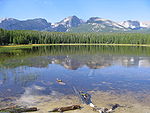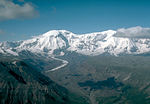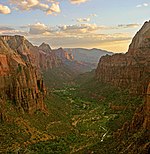Running and Fitness
1. Sub-4 Marathon
2. Sub-1:50 Half Marathon
3. 50k
4. Try a Tri
--10/2016: Rock and Run Marathon Relay, Percy Warner, TN
--3/2015: Cumberland Cycling Club 15k
--04/2016: Shade Tree Trot 5k
8. Bike a Century
--02/2016: Big Sky.
--04/2016: Virginia Portion of the AT
--11/2019: Baja California, Mexico
Travel and Adventure
--02/2014: Selvatura, Costa Rica
2. Climb Machu Picchu
--2/2019: Summited!
4. Climb Mount Whitney
5. Hike the Grand Canyon Rim-to-Rim
6. Hike to Everest Base Camp
--10/8/2017: Summited!
--6/26/15: Mount Norquay, Banff National Park, Canada
National Parks (7/59):
-8th/9th grade (?) with my Family. Lovely.
2. American Samoa
3. Arches, Utah
4. Badlands, South Dakota
5. Biscayne, Florida
6. Black Canyon of the Gunnison, Colorado
--05/2016
8. Canyonlands, Utah
9. Capital Reef, Utah
10. Carlsbad Caverns, New Mexico
11. Channel Islands, California
12. Congaree, South Carolina
13. Crater Lake, Oregon
14. Cuyahoga Valley, Ohio
--11/2020
16. Denali, Alaska
17. Dry Tortugas, Florida
18. Everglades, Florida
19. Gates of the Arctic, Alaska
--08/2014. LOVE.
21. Glacier Bay, Alaska
--05/2016
--08/2020
24. Great Basin, Nevada
25. Great Sand Dunes, Colorado
-Many, many, many. Most recently, 10/2013.
27. Guadalupe Mountains, Texas
--11/2016
29. Hawaii Volacanos, Hawaii
-07/2014.
31. Isle Royale, Michigan
--11/2020
33. Katmai, Alaska
34. Kenai Fjords, Alaska
35. Kings Canyon, California
36. Kobuk Valley, Alaska
37. Lake Clark, Alaska
38. Lassen Volcano, California
40. Mesa Verde, Colorado
41. Mount Rainier, Washington
42. North Cascades, Washington
43. Olympic, Washington
44. Petrified Forrest, Arizona
| 501,563 | This area constitutes over 4,000 archaeological sites of the Ancestral Puebloan people, who lived here and elsewhere in the Four Corners region for at least 700 years. Cliff dwellings built in the 12th and 13th centuries include the famous Cliff Palace, which has 150 rooms and 23kivas, and the Balcony House, with its many passages and tunnels.[48](WHS) | |||||
| Mount Rainier |  | Washington 46.85°N 121.75°W | March 2, 1899 | 235,625.00 acres (953.5 km2) | 1,264,259 | Mount Rainier, an active stratovolcano, is the most prominent peak in theCascades, and is covered by 26 named glaciers including Carbon Glacierand Emmons Glacier, the largest in the contiguous United States. The mountain is popular for climbing, and more than half of the park is covered by subalpine and alpine forests and meadows seasonally in bloom with wildflowers. Paradise on the south slope is one of the snowiest places in the world, and the Longmire visitor center is the start of the Wonderland Trail, which encircles the mountain.[49] |
| North Cascades |  | Washington 48.70°N 121.20°W | October 2, 1968 | 504,780.94 acres (2,042.8 km2) | 23,865 | This complex encompasses two units of the national park itself as well as the Ross Lake and Lake Chelan National Recreation Areas. The highly glaciated mountains are spectacular examples of Cascade geology; popular hiking and climbing areas include Cascade Pass, Mount Shuksan, Mount Triumph, and Eldorado Peak.[50] |
| Olympic |  | Washington 47.97°N 123.50°W | June 29, 1938 | 922,650.86 acres (3,733.8 km2) | 3,243,872 | Situated on the Olympic Peninsula, this park straddles a diversity of ecosystems from Pacific shoreline to temperate rainforests to the alpine slopes of Mount Olympus. The scenic Olympic Mountains overlook theHoh Rain Forest and Quinault Rain Forest, the wettest area in the continental United States.[51] (WHS) |
| Petrified Forest |  | Arizona 35.07°N 109.78°W | December 9, 1962 | 93,532.57 acres (378.5 km2) | 836,799 | This portion of the Chinle Formation has a great concentration of 225-million-year-old petrified wood. The surrounding Painted Desert features eroded cliffs of wonderfully red-hued volcanic rock called bentonite. There are also dinosaur fossils and over 350 Native American sites.[52] |
| Pinnacles |  | California 36.48°N 121.16°W | January 10, 2013 | 26,605.73 acres (107.7 km2) | 196,635 | Named for the eroded leftovers of a portion of an extinct volcano, the park is famous for its massive black and gold monoliths of andesite andrhyolite, which are popular with rock climbers, and a hiker's paradise of quiet trails crossing scenic Coast Range wilderness. The park is home to the endangered California condor (Gymnogyps californianus) and one of the few locations in the world where these extremely rare birds can be seen in the wild. Pinnacles also supports a dense population of prairie falcons, and more than 13 species of bat which populate its talus caves.[53] |
| Redwood |  | California 41.30°N 124.00°W | October 2, 1968 | 112,512.05 acres (455.3 km2) | 429,166 | This park and the co-managed state parks protect almost half of all remaining coastal redwoods, the tallest trees on earth. There are three large river systems in this very seismically active area, and 37 miles (60 km) of protected coastline reveal tide pools and seastacks. The prairie, estuary, coast, river, and forest ecosystems contain a huge variety of animal and plant species.[54] (WHS) |
| Rocky Mountain |  | Colorado 40.40°N 105.58°W | January 26, 1915 | 265,828.41 acres (1,075.8 km2) | 3,434,751 | Bisected north to south by the Continental Divide, this portion of theRockies has ecosystems varying from over 150 riparian lakes to montane and subalpine forests to treeless alpine tundra. Wildlife including mule deer, bighorn sheep, black bears, and cougars inhabit its igneous mountains and glacier valleys. Longs Peak, a classic Coloradofourteener, and the scenic Bear Lake are popular destinations, as well as the famous Trail Ridge Road, which reaches an elevation of more than 12,000 feet (3,700 m).[55] |
| Saguaro |  | Arizona 32.25°N 110.50°W | October 14, 1994 | 91,439.71 acres (370.0 km2) | 673,572 | Split into the separate Rincon Mountain and Tucson Mountain districts, this park is evidence that the dry Sonoran Desert is still home to a great variety of life spanning six biotic communities. Beyond the namesakegiant saguaro cacti, there are barrel cacti, chollas, and prickly pears, as well as lesser long-nosed bats, spotted owls, and javelinas.[56] |
| Sequoia |  | California 36.43°N 118.68°W | September 25, 1890 | 404,051.17 acres (1,635.1 km2) | 1,039,137 | This park protects the Giant Forest, which boasts some of the world's largest trees, the General Sherman being the largest in the park. It also has over 240 caves, a scenic segment of the Sierra Nevada including thetallest mountain in the contiguous United States, and Moro Rock, a photogenic granite dome.[57] |
| Shenandoah |  | Virginia 38.53°N 78.35°W | May 22, 1926 | 199,045.23 acres (805.5 km2) | 1,255,321 | Shenandoah's Blue Ridge Mountains are covered by sprawling hardwood forests that teem with tens of thousands of animals. The Skyline Driveand Appalachian Trail run the entire length of this narrow park, along with more than 500 miles (800 km) of hiking trails passing scenic overlooks and cataracts of the Shenandoah River.[58] |
| Theodore Roosevelt |  | North Dakota 46.97°N 103.45°W | November 10, 1978 | 70,446.89 acres (285.1 km2) | 559,580 | This region that enticed and influenced President Theodore Rooseveltconsists of a park of three units in the northern badlands. Besides Roosevelt's historic cabin, there are numerous scenic drives and backcountry hiking opportunities. Wildlife includes American bison,pronghorn, bighorn sheep, and wild horses.[59] |
| Virgin Islands |  | United States Virgin Islands 18.33°N 64.73°W | August 2, 1956 | 14,688.87 acres (59.4 km2) | 426,930 | The island of Saint John has rich human and natural histories. Taínoarchaeological sites and ruins of sugar plantations from Columbus' time litter the coast. Past the pristine beaches are mangrove forests, seagrass beds, coral reefs, and vast algal plains.[60] |
| Voyageurs |  | Minnesota 48.50°N 92.88°W | January 8, 1971 | 218,200.17 acres (883.0 km2) | 239,160 | This park protecting four lakes near the Canada–US border is a site for canoeing, kayaking, and fishing, and preserves a history populated byOjibwe Native Americans, French fur traders called voyageurs, and ambitious gold-miners. Formed by glaciers, the region features tall bluffs, rock gardens, scenic islands and bays, and several historic buildings.[61] |
| Wind Cave |  | South Dakota 43.57°N 103.48°W | January 9, 1903 | 28,295.03 acres (114.5 km2) | 542,022 | Wind Cave is distinctive for its calcite fin formations called boxwork and needle-like growths called frostwork. Additionally, it is the world's densest and most complex cave system. Above ground is a mixed-grass prairie with animals such as bison, black-footed ferrets, and prairie dogs.[62] andponderosa pine forests home to cougars and elk. It is culturally significant to the Lakota people as the site in which their emergence story takes place. |
| Wrangell–St. Elias |  | Alaska 61.00°N 142.00°W | December 2, 1980 | 8,323,147.59 acres (33,682.6 km2) | 74,722 | An immense plot of mountainous country protects the convergence of the Alaska, Chugach, and Wrangell-Saint Elias Ranges, which include many of the continent's tallest mountains and volcanoes, including the 18,008-foot Mount Saint Elias. More than a quarter of the park is covered with glaciers, including the tidewater Hubbard Glacier, piedmont Malaspina Glacier, and valley Nabesna Glacier.[63] (WHS) |
| Yellowstone |  | Wyoming,Montana,Idaho 44.60°N 110.50°W | March 1, 1872 | 2,219,790.71 acres (8,983.2 km2) | 3,513,484 | Situated on the Yellowstone Caldera, the park has an expansive network of geothermal areas including vividly colored hot springs, boiling mud pots, and regularly erupting geysers, the best-known being Old Faithfuland Grand Prismatic Spring. The yellow-hued Grand Canyon of theYellowstone River has a number of scenic waterfalls, and four mountain ranges run through the park. More than 60 mammal species includinggray wolves, grizzly bears, lynxes, bison, and elk, make this park one of the best wildlife viewing spots in the country.[64] (WHS) |
| Yosemite |  | California 37.83°N 119.50°W | October 1, 1890 | 761,266.19 acres (3,080.7 km2) | 3,882,642 | Yosemite features towering granite cliffs, dramatic waterfalls, and old-growth forests at a unique intersection of geology and hydrology. Half Dome and El Capitan rise from the park's centerpiece, the glacier-carvedYosemite Valley, and from its vertical walls drop Yosemite Falls, North America's tallest waterfall. Three giant sequoia groves, along with a pristine wilderness in the heart of the Sierra Nevada, are home to an abundance of rare plant and animal species.[65] (WHS) |
| Zion |  | Utah 37.30°N 113.05°W | November 19, 1919 | 146,597.60 acres (593.3 km2) | 3,189,696 | Located at the junction of the Colorado Plateau, Great Basin, and Mojave Desert, this geological wonder has colorful sandstone canyons, mountainous mesas, and countless rock towers. Natural arches and exposed plateau formations compose a large wilderness roughly divided into four ecosystems: desert, riparian, woodland, and coniferous forest.[66] |
S


No comments:
Post a Comment